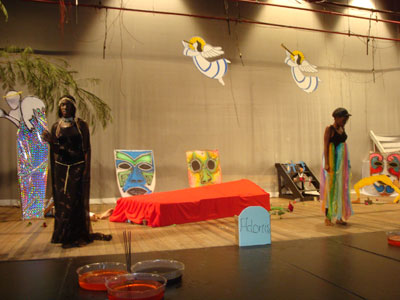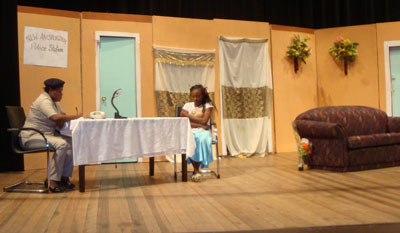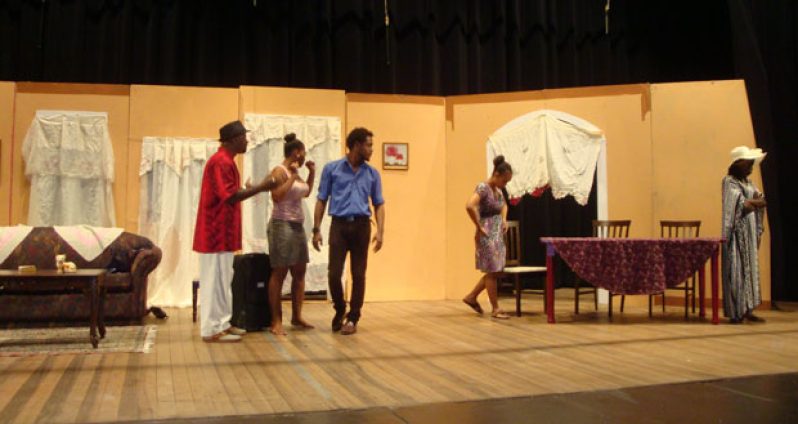THE National Drama Festival which had been ongoing at the National Cultural Centre for the last two weeks came to a close on Friday night with four plays.

The festival had produced plenty of thrills and breathtaking moments for theatre lovers, but the performances had also been plagued by several problems, some of which were technical while others were human.
The technical problems related to the lighting, video and sound which often did not come off as planned, and hence detracted from the performances; which can be described as very good, considering that most of the playwrights as well as actors were recently trained in the field.
The human problems were more related to punctuality, as plays often started long after their scheduled time and continued well into the night, impacting on attendance, as many members of the audience, especially the young, could not stay awake that late.
When Friday night’s performances concluded, just before midnight, only a small audience remained.

The first of the final four plays that were staged on Friday night was “Creative Burial Ground.” This is a play which was very different from anything I’ve seen thus far, because it dealt with a subject matter that most people don’t dwell much on — life after death.
The play chronicled the escapades of four artists, three men and one woman, who after death, wake up in a cemetery. From all indications, they are in an in-between state, which is neither heaven nor hell, as Christians believe; or any other final resting place, whatever it may be for those who believe differently.
But since they were artists when they were alive, it appears that their creative ability had not left them. They also still had strong opinions about many issues, one of which was the essence of God. The woman, “Ororo”, questioned whether God’s creations were perfect. The three men argued that God was indeed perfect, and so is everything He has created. But Ororo is stubborn and points to “mosquitoes” and “human beings” as examples of God’s imperfect creations.
Finally, they leave the subject of God for a moment, as one of the men, who happened to be a painter in life, got the impulse to paint. When the others reminded him that he didn’t have a brush and paint with which to paint he told them that he could paint using his imagination. He began painting using his imagination, which was projected onto the wall of the stage. His friends were enthralled and amazed by what he had created.
He was immediately followed by another friend, who jumped up and declared his desire to sing a song. Encouraged by his friends, he began to sing.
In the next scene, Ororo was alone until she was confronted by an angel, who descended from heaven to defend the honour of God. However, Ororo did not budge from her views, and soon she was locked in a sword battle with the angel, from which she emerged victorious.
In the following two scenes, Ororo interacted first with a being from another solar system, who crowned her as the god of earth. But the ever opinionated Ororo was not satisfied, and wanted to know why the gods waited until now to intervene in the affairs of earth.
In the last scene, she interacted with another character who, rather than arguing with her, charmed her, and she fell for his charms.
The judges gave “Creative Burial Ground”, written by Ray Wiltshire, high marks for the set, which they described as “beautiful” and “artistically functional”, as well as the costumes and portrayal of the characters.
Duplicity
Next up was the play “Duplicity”. Written by Kieran Bruce, this play lived up to its name by delivering tales of deception.
The play started off with a scene of a TV newsreader reporting on the rape of a teenager. Then the play shifted to the New Amsterdam police station, where the victim was being interviewed by a female police officer. But they were soon interrupted by a male policeman who entered the station and informed the lieutenant interviewing the victim that they located the suspect, who resisted arrest and was subsequently injured by the cops, as they subdued him.
In the scene that followed, a woman was in the shower when there was a knock on the door. She came out in a robe, and it turned out that the man who entered was her boyfriend. However, he did not have good news for her. As it turned out, he was ending their relationship because he was getting married to another woman, Sherry.
The woman, who became enraged, accused the man of going back on his promises, and threatened to tell the police, as well as Sherry, that he was a rapist who had molested her since she was 13 years of age. She also threatened to tip-off police about the existence of a marijuana plantation at the back of the house.
The man, Ryan Sinclair, exploded in anger and pulled out a knife as he pushed the woman down on the couch, threatening to stab her. But he got up without stabbing her, and as he turned his back on her, she hit him behind the head with a glass and he collapsed.
She took the knife, and just as she thought about stabbing him, a little boy came in and asked her what she was doing to Uncle Ryan.
She turned around and accidentally stabbed the boy.
Shocked at what she had done, she decided to put the knife in Ryan’s hand. When he regained consciousness, she accused him of killing the boy, and called the police.
In the next scene, the newsreader announced that the police had arrested Ryan Sinclair for the murder of the boy.
Deep Wounds
The third play was entitled “Deep Wounds.” It chronicled the often thorny relationship between two police detectives, an Afro-Guyanese female and an Indo-Guyanese male. It appears that the female officer’s brother had died at the hands of the police, and she had blamed it on the Indian-dominated Government. This led to persistent arguments between her and her Indo-Guyanese partner.
It all came to a head when a group of Afro-Guyanese bandits invaded an event where the Indo-Guyanese president of the country was busy addressing an Indian-dominated audience. The bandits overwhelmed the president’s security detail and took everyone hostage. The president was totally at the mercy of the bandits, who hurled abuse at him.
The female detective and her partner are the only backup that arrived, but since she blamed the president and his policies for her brother’s death, she hesitated despite her partner urging her on to take action and save the president.
But eventually her sense of duty took over, and she and her partner surprised the bandits and rescued the president, who had a bomb strapped to his body by the bandits.
But it is not yet over, and nerve-wrecking moments follow, as the police detective, who was not really trained in disabling bombs, attempts to disable the bomb as the minutes ticked away. Finally, they all heave a sigh of relief as he disabled the bomb with just seconds remaining.
The experience transformed Sara, the Afro-Guyanese detective, who had finally been able to forgive the Indo-Guyanese-led government for the death of her brother.
In the final scene, her grandmother appeared and thanked her for finally being able to forgive.
Students from Tutorial High School played the role of the audience that was being addressed by the president, and subsequently held hostage by the bandits. They played their roles very well, especially when portraying the terror scenes after the bandits struck.
Faith
The final play of the evening revolved around the lives of two families that were intertwined, when a teenage couple discovered in a strange set of circumstances that they were in fact brother and sister. Faith, the daughter of a single mother, always wanted to know the identity of her father, but her mother kept telling her he was dead. That’s until she received a phone call from a strange man, who seemed to know too much about her.
The man told her that he was a friend of her father who was, in fact, alive. He pointed her to a suitcase, where she found a saxophone and a letter which revealed that her father had wanted to meet her since she was 12 years of age; but that her mother, in trying to spite him, had denied him access to his daughter.
When she told her boyfriend the name of the man who had called her, he shocked her by telling her that the man who had called her was actually his dad.
When her mother arrived, the girl confronted her mother with what she discovered. The mother, who was in the company of a friend, confessed that the man who had called was not a friend of her father’s, but was actually her father. At the same time, the friend of the mother recognized the boyfriend as her son.
Not long thereafter, the father, who had been called by the daughter, “Faith”, arrived and set the record straight. He told Faith that he hadn’t abandoned her, and that he had always wanted to have a relationship with her, but that her mother had prevented him from doing so.
In the end, they all embraced and forgave each other.
When I asked audience members which plays they enjoyed the most, most of them picked scenes from the plays “Deep Wounds” and “Duplicity”, because they could identify with the characters, as these scenes play out daily in their lives.
I also spoke with one of the actors in the plays, Kiefer Smith, who acted in both “Duplicity” and “Deep Wounds”, about how he found the roles he portrayed. He told me that “Bamboo Alley”, which was shown earlier during the festival, was the most challenging play he had acted in, while he had the most fun in “Deep Wounds.”
This young man also shared with me his deep passion for the theatre arts, and how he is learning more to keep alive what he referred to as “a dying art form in Guyana”.
(By Jimmy Roos)




.png)









